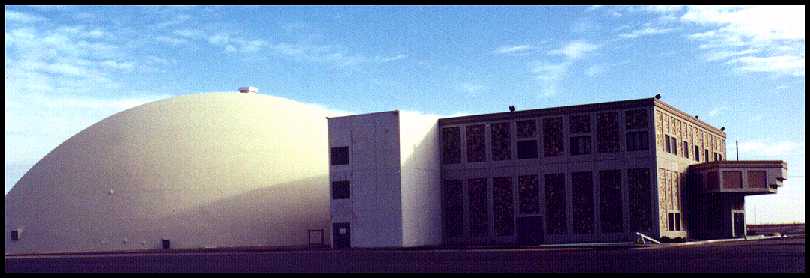

Sternberg Museum of Natural History

The Unofficial Virtual Tour
Copyright © 2000-2012 by Mike Everhart
Last updated 06/10/2012
| In March, 1999, the Sternberg Museum of Natural History re-opened it's doors in a large, new facility. The new museum is a wonderful mixture of the many spectacular (and unique) exhibits that were once housed in McCartney Hall on the campus of Fort Hays State University, and many new, state-of-the-art re-creations of prehistoric life. Click here for the official Sternberg Museum of Natural History webpage and general information regarding how to get to the museum, admissions, memberships and programs. |
The pictures that follow are generally of my favorite subjects (Late Cretaceous marine life) but I've thrown in a couple of images of our huge Tyrannosaurus rex that should please the dinosaur fans.
 |
One of the first things you will see on the east side of Hays, Kansas, as you approach the museum from the east on Interstate-70 are the largest pictures in the world of a Pteranodon sternbergi, located on a water tower near the museum. The Sternberg Museum has the type specimen of P. sternbergi on display. There are many exhibits in the museum, and many more to come as work is completed over the next several years. |
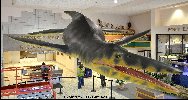 |
The first thing that you see when you walk in the front door is a reconstruction of the giant Kansas pliosaur Brachauchenius lucasi (remember how big it is when you see the T-rex upstairs... the skull is actually a foot longer than that of T-rex.). Then you can take the elevator to the third floor where you begin your journey with dinosaur exhibits from the edge of Western Interior Sea, an ocean covered Kansas and most of the Midwest more than about 85 million years ago. |
 |
Looking down from the walkway leading to the dinosaur diorama on the third floor, you can see the exhibits of many of the familiar Sternberg Museum fossils and a recreation of a famous discovery event in the history of the Sternberg Museum (see below). There are many unique fossils on display here, and we will get to them shortly. |
 |
Towering above everything else, except the pteranodons and the trees on the third level is everyone's favorite dinosaur, Tyrannosaurus rex. This T-rex is a well done re-creation of a very large individual and is animated just enough to get everyone's attention. In this diorama, the T-rex is stalking a herd of hadrosaurs moving along the western shore of the Western Interior Sea. |
 |
This T-rex is so large that it is difficult
to get all of her in one picture. The kids will really enjoy this exhibit (as will
the rest of us that never really 'outgrew' dinosaurs). Be prepared, however, for a T-rex
sized growl or two.... ..... and yes, the Sternberg Museum does have a real Kansas dinosaur. |
 |
Soaring in from feeding at sea, a flock of adult Pteranodon sternbergi head for their nesting sites. These re-creations of fossils first found in the Smoky Hill Chalk over a hundred years ago, and have wing spans of 20 feet or more. They are truly impressive to see overhead and must have been even more so in real life. |
 |
Beak to nose view of the same flock of Pteranodon sternbergi coming home from feeding at sea. |
 |
Here a small short-necked (polycotylid) plesiosaur, comes ashore. Originally called "Trinacromerum", these animals have been re-examined and re-named as "Dolichorhynchops" Approximately the size of a modern sea lion, it is unlikely that these animals were able to move about on land. |
 |
A close-up of the reconstructed head of Dolichorhynchops. The 'behind the scenes' story is that since this is the re-creation of an important museum specimen, the options were to show it either moving on the beach, or as a dead animal that had been washed ashore. I think this was the best choice. |
 |
Dolichorhynchops and other plesiosaurs ate fish that they caught in their long, narrow jaws. Looking ungainly on land, they were masters of underwater 'flight' in the ocean, using their two sets of aerodynamic paddles to literally fly through the water. The Sternberg has a complete, 3-D mount of only the third known, complete specimen of this animal on display in the exhibit area (see pictures below). Read more about this specimen HERE. |
 |
|
 |
As we descend down the passageway from the Cretaceous shoreline to the depths of the Western Interior Sea, we come face to face with a medium sized Xiphactinus audax (he's only 13 feet long.... they grew to lengths of 18 feet or more!) |
 |
This Xiphactinus re-creation is decked out in modern 'Blue Marlin' colors and looks very believable. This fish probably fed mostly on smaller fish and, as evidenced by the specimen in the exhibit area, swallowed them headfirst and whole. |
 |
Xiphactinus audax was a primitive teleost fish and is probably not related to any modern marine fishes. It was a fast swimmer and would have looked (and probably behaved) much like a modern Tarpon on steroids. |
 |
The business end of a Xiphactinus audax. The teeth were long (three inches or more), and spike-like, and were used for seizing prey. This fish simply 'inhaled' the food that it ate. It was a very successful species and its remains are found around the world. |
 |
The next animal that we encounter in our underwater journey is a re-creation of a large (30+ foot) mosasaur called Tylosaurus proriger. These large marine reptiles were very common in the Western Interior Seaway, and are represented by numerous, well preserved fossils. |
 |
Mosasaurs had large, triangular shaped heads and jaws that were lined with sharp, curved teeth. They used their teeth to capture and kill their prey, and then swallowed their prey whole. |
 |
This would not be a good place to be ...... 85 million years ago. |
 |
Finally we reach the bottom of the sea, 400 to 600 feet below the surface. On the soft muddy bottom we see large inoceramid clams (Platyceramus platinus) and groups of smaller, colonial rudists (Durania maxima). Small fish, including pycnodonts such as Micropycnodon kansasensis, fed on encrustations on the larger shells and schools of tiny fish actually shelter inside some of the larger inoceramids. Shell-crushing sharks (ptychodontids) most likely fed on smaller clams and shellfish. |
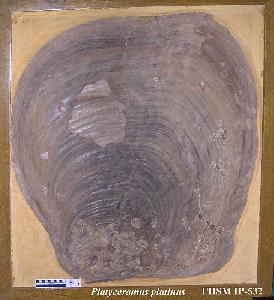 |
During most of time when the Smoky Hill Chalk was being deposited in Kansas, the ocean bottom supported large inoceramid clams like this museum specimen of Platyceramus platinus. This large (3 ft by 3.5 ft) specimen was collected by George F. Sternberg. |
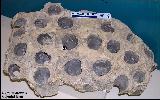 |
There were also colonies of reef building, colonial clams (rudists) called Durania maxima. The specimen at left is an excellent example of the colonial form. Since Kansas was on the extreme northern range of this species, however, most of the Durania shells that we find are those of solitary individuals. |
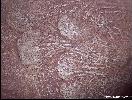 |
The only echinoderms (similar to modern sea creatures like starfish and sea urchins) that are known from the Smoky Hill Chalk are colonial crinoids called Uintacrinus socialis. They are only found together in large groups that may represent mass death assemblages. The best specimens come from Kansas. At left is a detail from a large specimen found in Logan County by George F. Sternberg. |
 |
Large squid called Tusoteuthis longa lived in the Western Interior Sea. Sometimes their internal support structures, called a squid pen or gladius, are preserved in the chalk. |
 |
The first exhibit you will see on the second floor is a diorama recreating the 1952 dig on one of the most famous (or at least, the most well known) fossils in the world... .the 'Fish-Within-A-Fish' specimen of Xiphactinus audax. A life-size model of George F. Sternberg is shown there carefully cleaning the fossil as found on a site in Gove County, Kansas. Click here for information about "The other George Sternberg"... He was the brother of Charles H. Sternberg, the uncle of George F., and was one of the first fossil collectors in Kansas. |
 |
This is the mounted version of the 'Fish-Within-A-Fish' Xiphactinus audax that was recovered by George Sternberg in 1952. Note that this is the bottom side of this fossil as discovered. When the specimen was being worked on the in field, the top portion was cleaned off and then covered with a layer of plaster that eventually became the background of the fossil when it was turned over and prepared. This is probably the most photographed fossil specimen in the world. (Click here for a much larger picture - 180 KB) |
 |
Another skull of Xiphactinus audax in another museum display. Click here for a detailed drawing of a Xiphactinus audax skull. |
 |
Ichthyodectes was a smaller version of Xiphactinus and probably grew to lengths of ten feet or more. Note that the teeth in Ichthyodectes are much smaller and more uniform in size. (Photo of a juvenile (4 ft.) Ichthyodectes) |
 |
Once we enter the exhibit area, we find many cases of specimens from the Smoky Hill chalk and other late Cretaceous formations in Kansas. This specimen of Pachyrhizodus minimus (FHSM VP-326 - about 3 feet long) is preserved so well that the shape of some internal organs are still visible. Click here for the Pachyrhizodus webpage. |
 |
The remains of a medium sized fish called Pentanogmius (Bananogmius) evolutus. |
 |
Apsopelix was a small fish (less than 1.5 feet) that probably lived in large schools and occasionally preserved in 3-D. Click here for another picture of this specimen. |
 |
Enchodus petrosus, the "saber-toothed fish" of the Cretaceous Period, was a small fish with very large fangs. Click here for the Enchodus webpage. |
 |
Protosphyraena looked something like a modern swordfish. It also had long, saw toothed fins. Click here for the Protosphyraena webpage. |
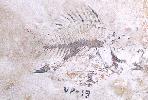 |
Small fish are seldom preserved in the chalk. The Sternberg Museum has the type specimen of Kansius sternbergi (FHSM VP-19) on exhibit. (About 3 inches in length). A more complete specimen of Kansius sternbergi (FFHM 1972-128) on an inoceramid clam shell can be seen in the collection of the Fick Fossil and History Museum, Oakley, KS. |
 |
Pycnodonts were small to medium-sized, deep-bodied bony fish with round, flattened teeth that are well adapted for crushing food items. It is possible that these fish "nibbled" on the invertebrates and algal growths (epifauna) that were attached to inoceramid shells at the bottom of the Western Interior Sea. (LEFT) A weathered, partial right pre-articular toothplate of Coelodus stantoni (FHSM VP-7280 - Carlile Shale) in the collection of the Sternberg Museum . Click here for the Pycnodont webpage. |
 |
Sharks, like Cretoxyrhina mantelli, grew as large as 20 or more feet long and had razor sharp teeth. This specimen at the Sternberg Museum was collected by G.F. Sternberg in 1965 and is so well preserved that the teeth are still in place in the jaws. Click here to see a picture of the head of this specimen (VP-2187). For a drawing of the entire specimen by Kenshu Shimada, click here. Additional pictures of teeth: Here, here and here. See a webpage about the newest Ginsu Shark in the Sternberg collection here. |
 |
A large and nearly complete skull of Cretoxyrhina mantelli (VP-323). In this specimen, the jaws (and teeth), and most of the vertebrae were preserved. A larger picture is located HERE. A close-up of the teeth is found HERE. This specimen was found by a 7 year-old boy (Julian Taylor) in August, 1950, three miles SE of Elkader in SW Gove County, KS. Click here for more about Kansas shark teeth. |
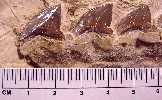 |
Several teeth from an excellent specimen of Squalicorax kaupi (FHSM VP-2213) in the collection of the Sternberg Museum. This specimen includes preserved (calcified cartilage) and articulated teeth. |
 |
The jaw plate of Ptychodus mortoni , a shell crushing shark from the Late Cretaceous of Kansas. |
 |
The five foot long skull of a large pliosaur (short necked plesiosaur) called Brachauchenius lucasi. A complete specimen of this animal has not been found yet, but from the various parts that have been recovered, it must have been very massive. It is probably related to a large pliosaur from Australia called Kronosaurus and was 20 to 25 ft. long. Chick here for Dan Varner's paleo-life art version. Click here for a larger picture of this specimen (VP-321) and HERE for detailed close-up photographs. |
 |
The nearly complete shell of a large marine turtle called Protostega (with head and limbs added). This animal grew to lengths of 9 or more feet (tip of nose to tip of tail) and probably looked like a modern sea turtle (just MUCH larger, about the size of a Volkswagen!). Click here for the Cretaceous Turtles webpage. |
 |
The front half of the skeleton of a medium sized mosasaur called Platecarpus (FHSM VP-2116). Click here for a picture of the skull. Although mosasaurs came from the land during the middle to late Cretaceous, they adapted quickly and very successfully to life in the oceans. In fact, their legs were so greatly modified into paddles for swimming that they would have been nearly useless on land. Click here for more specimens in the Platecarpus Virtual Mosasaur Museum |
 |
This is the nearly perfect skull of the large (29 foot) Tylosaurus proriger (FHSM VP-3) that is mounted on the north wall of the exhibit area. This specimen was found by George F. Sternberg's son, Charles W., in Logan county in 1927 and was prepared by G.F. Sternberg. It was purchased for the museum by the Senior Class (1927) of the Kansas State Teachers College (Now Fort Hays State University). Click here for more specimens in the Tylosaurus Virtual Mosasaur Museum. |
 |
The business end of a Tylosaurus. Interlocking teeth and strong jaws made it nearly impossible for any prey to get away from this monster of the Western Interior Sea. In 1930, George F. Sternberg wrote regarding this specimen, "Recently I mounted a skeleton, now on the walls of the Kansas State Teachers College [Fort Hays State University] at Hays, which is thirty and one-half feet long. It has a skull four feet long. Four paddles helped propel his powerful body through the water. It was carnivorous, living on the flesh of many animals which inhabited these same waters. This is not the largest mosasaur known, nor is it the smallest." |
 |
The back of the skull of the same Tylosaurus. His/her brain would have been about the size of your clenched fist. These guys were not mental giants by any stretch of the imagination, but when you're the biggest and the baddest critter in the ocean, maybe brain power wasn't that big a deal. |
 |
A close-up of the rear, left-side of the skull, showing the characteristic shape of the quadrate. |
 |
Mosasaur limbs were highly modified for life in the oceans. This Tylosaurus rear paddle shows the increased number of digits in the 'foot'. |
 |
If you were swimming in the middle of the Western Interior Sea, this would probably be the best part of a mosasaur to see...... going away from you. |
 |
Ichthyosaurs became extinct by the early part of Late Cretaceous, and the deposition of the Smoky Hill Chalk in Kansas. This is a cast of the skull of a large ichthyosaur (Platypterygius) from Wyoming. The only ichthyosaur remains known from Kansas is a partial vertebrae from the Kiowa Shale Formation (Albian age / Early Cretaceous) in southern Kansas (Clark County). It is about 10 cm (4 in.) across and represents a fairly large individual. |
 |
Here we see the distinctive crest on the skull of the type specimen of Pteranodon sternbergi. No one is really sure what purpose this large bony structure served. |
 |
In addition to having claws on their wing fingers, pteranodons had clawed hind feet for walking on the ground. |
 |
Nyctosaurus bonneri was a smaller pterosaur that lived at the same time as Pteranodon. This is a picture of the type specimen. More information about Pteranodon HERE |
 |
Ichthyornis dispar, a small, gull or tern-like Late Cretaceous bird with teeth, as depicted in a mural at the Sternberg Museum. The first Ichthyornis was found by Professor B. F. Mudge in the summer of 1872, and first described (without teeth) by O. C. Marsh later that same year. Marsh's restoration of the skeleton is here; the lower jaw is here. A mounted partial skeleton found by J. D. Stewart in Graham County is on exhibit at the the Sternberg Museum: FHSM VP-2503; a larger version (life-size) is shown HERE . |
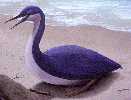 |
Hesperornis regalis was a large (up to 5 feet in total length) flightless bird (with teeth) that lived in the northern reaches of the Western Interior Sea. Although the first remains of this bird were found in Kansas in the 1870s, they are far more common further north. This picture of a nesting Hesperornis is from the large seashore mural at the Sternberg Museum. Click here to see Williston's 1898 note on toothed birds, including Hesperornis. |
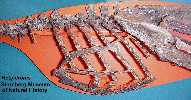 |
These pictures show details of a mounted, partial specimen of Hesperornis regalis at the Sternberg Museum (FHSM VP-2069). Unfortunately, the skull was not found with this specimen. (LEFT: Ribs; RIGHT: Rear leg and hip; FAR RIGHT: Foot) | 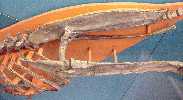 |
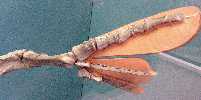 |
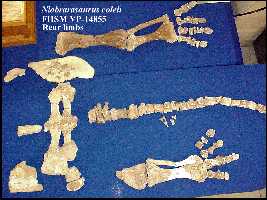 |
On May 1, 2003, a news conference was arranged at the Sternberg Museum to announce the acquisition of the type specimen of Niobrarasaurus coleii from the University of Missouri-Columbia. I spent the morning arranging a display of the bones of Niobrarasaurus on a piece of dark blue cloth and talking to reporters and photographers who arrived early. It was possibly the first time that the specimen (now FHSM VP-14855) had been laid out completely since it was first prepared, and certainly the first time that it had been photographed so extensively. On May 3, after most of the news stories had played out, I took a group of amateur paleontologists into the field. By coincidence, we were hunting fossils in the same section (square mile) that had produced the bones of Niobrarasaurus in 1930. The locality also happens to be one of my favorite areas of the chalk and one for which we had access from the property owners. And there begins the rest of this strange and wonderful story... |
This has been a brief look at the new Sternberg Museum of Natural History. There is a lot more to see and the best way to see it is to be there!